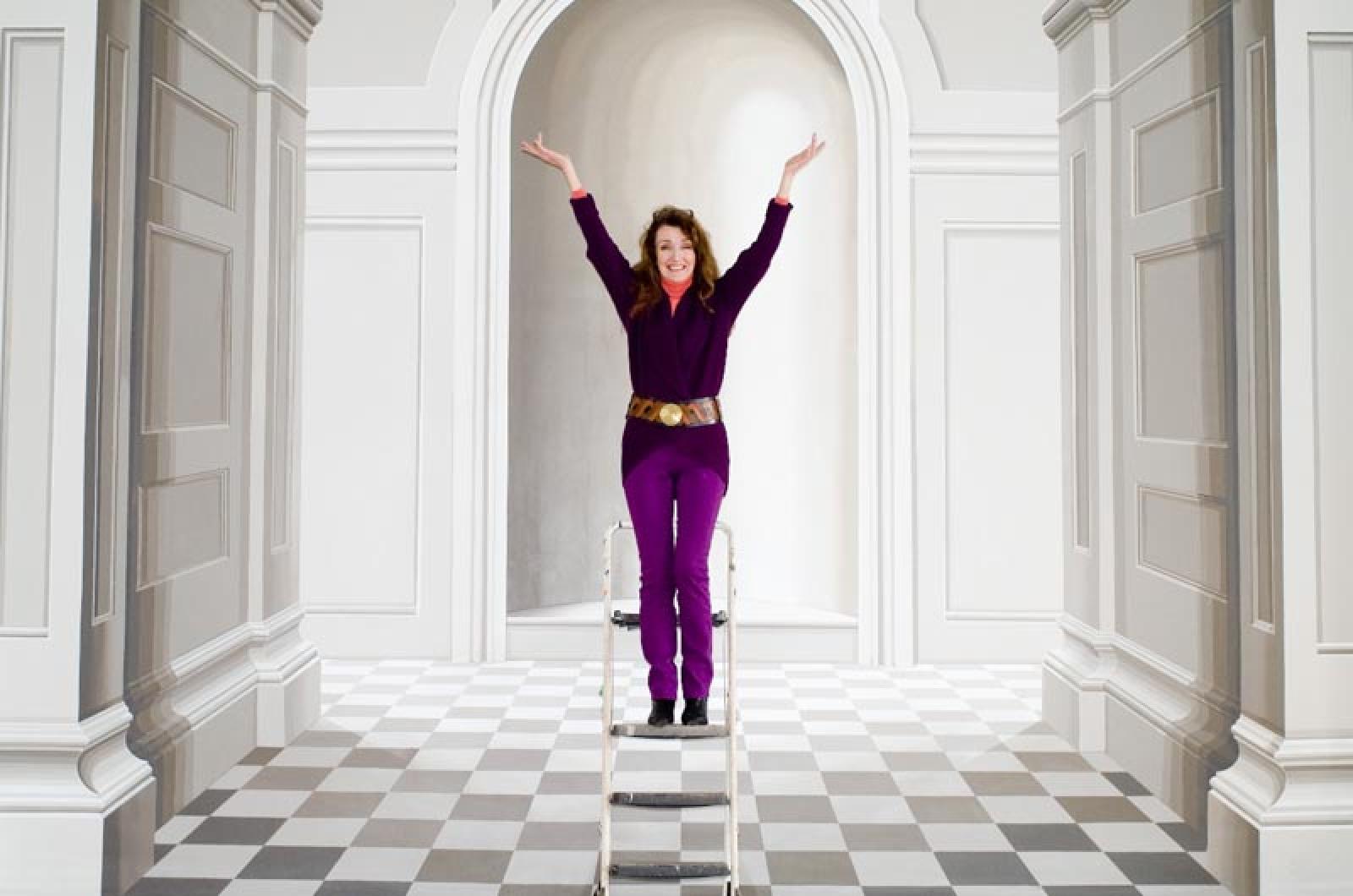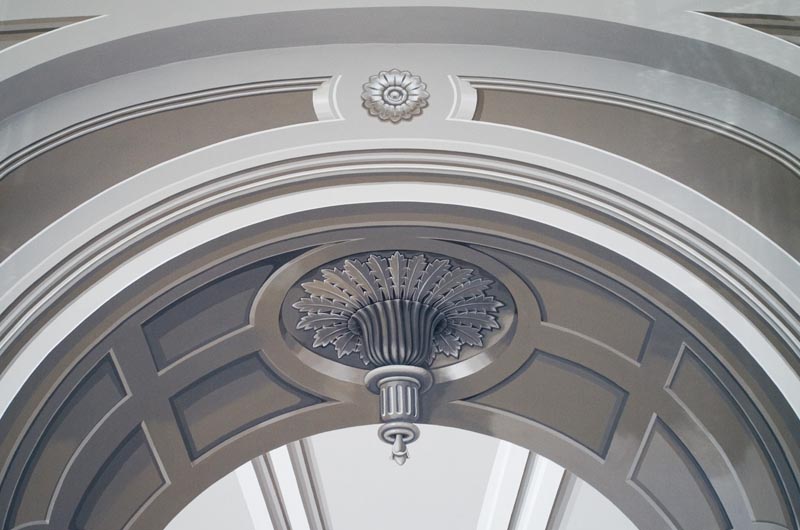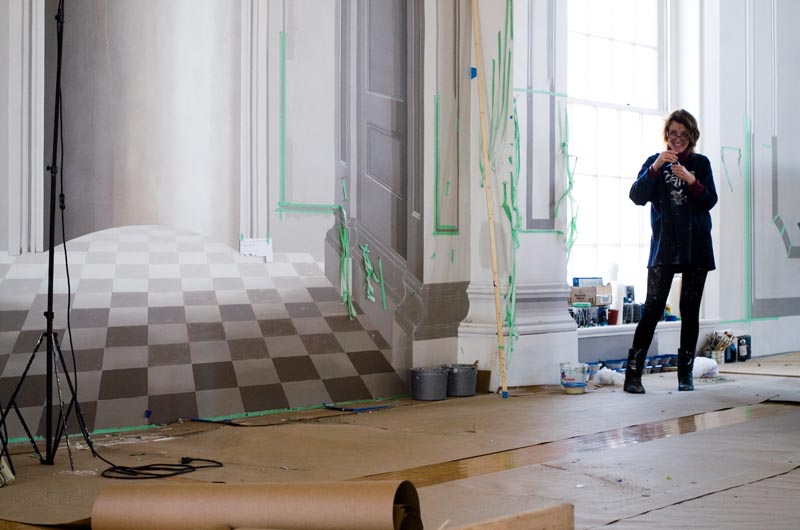When artist Margot Datz begins a new project she finds it hard to stop. “Until someone rips me off the wall I’m there,” she said on Wednesday morning at the Old Whaling Church in Edgartown.
Although no one is coming to rip Ms. Datz off the wall, her brother Stephen Datz is on hand to “help her out the door,” he said. Good thing, too, as this weekend there will be a wedding held at the church. Scaffolding and bridal gowns do not really mix. But magnificently-restored murals serving as a backdrop for wedded bliss definitely do.
Ms. Datz has been in residence at the church since Jan. 9, when she started restoring the mural on the back wall of the Greek revival church. The original mural was painted in the 1840s by Carl Wendt, who worked closely with architect Frederick Baylies on the building of many churches around New England. Although the Whaling Church has weathered the time well — it was completed in 1843 — the mural faded over the past 170 years. When Ms. Datz began the project, the wall was essentially blank, a mere backdrop for the wooden stage.
To meet this weekend’s wedding deadline, Ms. Datz has taken only two days off since Jan. 9. “At first I worked until 10 p.m. each night, then 11 p.m., then midnight, now 1 a.m. I feel guilty if I quit any earlier.”
She has been helped by her brother Stephen and her daughter Scarlet Blair. “She’s my favorite assistant in the whole world,” Ms. Datz said of her daughter. “And she puts up with me. For 10 years she’s been my backup. She has great precision.”
Ms. Datz also works frequently with Stephen, a sculptor by trade, including on a project at the Arkansas Children’s Hospital. “That mural was 80 feet long with 23 sculptures,” Stephen said. Mr. Datz lives in Skaneateles, N.Y. and has traveled back and forth to the Vineyard throughout the project.
“She’s definitely the lead brush,” he said of his sister. “We call her the instrument. Our job is to protect and facilitate the instrument.”
Recreating the mural, wich spans approximately 22 feet high and 60 feet wide, was an artistic and technical achievement. It also involved a fair amount of detective work. Only a few photos of the original mural remained and they were extremely overexposed, revealing to the naked eye just the barest of outlines.
“I spent hours with the photographs to the point of hallucination,” Ms. Datz said. “It was like looking at the mural in a snowstorm.”
Ms. Datz visited similar churches in Provincetown and Nantucket, both by the Baylies and Wendt team, to gather more clues. “I got to piggyback on the Nantucket research with regard to palette,” she said.
The original mural was done in egg tempera. For the restoration, Ms. Datz used latex paint and oils. And she used a lot of it.
“The side panels each needed about a half mile of paint,” Stephen Datz said. “That’s a mile of stripes on them.” He pointed to panels, the patterns of the mural perfectly offsetting the windows, which were letting in rays of bright sunshine. “The windows were absurd before, an architectural goofball,” he said, referring to the fact that when the side panels next to the arch were a blank canvas, the windows felt out of place and off-center. “Now it looks perfect.”
The interior arch required even more paint and even more technical complexities. “The main arch had 24 shades of gray,” Ms. Datz said. “It was miles of stripes. And every single line has to be exactly parallel or it sticks out.”
To create the desired effect, Ms. Datz had to blend in 10 shades of gray. “The drying time was impossible, almost drying on contact,” she said. “So it was almost impossible to blend.”
Ms. Datz gives much of the credit for the project to Chris Scott, the executive director of the Martha’s Vineyard Preservation Trust which owns the church.
“It was Chris Scott’s courage that got this project to happen,” Ms. Datz said. “He watched over the project like a lighthouse watches over a harbor.”
Mr. Scott visited the mural nearly every day over the past two months. “So many parts [of the church] make sense to me now,” he said. “The architecture was always a bit of a mystery to me. I always wondered why the windows weren’t centered on the walls.”
Mr. Scott also noticed a theological message being revealed as the mural took shape, particularly under the arch where it now appears one could walk through into an open space where a bright light shines from around an unseen corner.
“I was taken aback by the trompe l’oeil, going through the arch into the light-filled room. Oh, I get it now,” he said. “Moving through our world into the eternal light. There is no way this doesn’t have a meaning. Everything in those days was allegorical.”
Now that the mural is finished, there is the question of the other walls, all blank canvases awaiting restoration. “We definitely want to go to the next stage,” Mr. Scott said. “We don’t have any photos but we’re pretty sure of exactly what would be there.”
That project will have to wait, though. There is money to be raised and numerous spring and summer events ready to fill the Whaling Church now that the scaffolding has come down. This weekend a lucky bride and groom will be the first to experience the mural and its effects on the interior of the church.
“We feel differently in the church now,” Ms. Datz said as she put the last few touches on the mural. She will miss this weekend’s wedding, no artist celebration for her. On Saturday she heads to New Orleans to begin work on three more murals. But she looks forward to returning to the Island and experiencing the mural as a member of the audience. “I can’t wait to see the Chamber Music Society in front of it.”
To view a timelapse of Ms. Datz' work, click here.










Comments (13)
Comments
Comment policy »